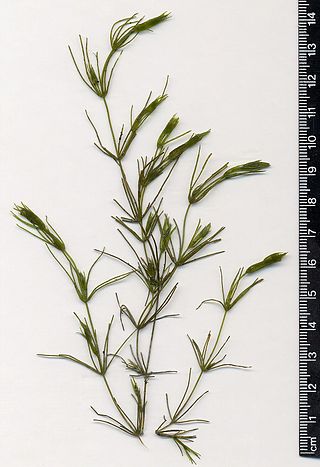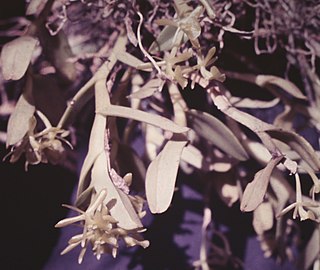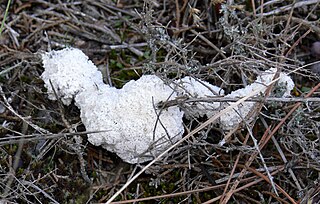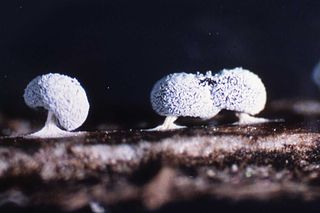
Genus is a taxonomic rank used in the biological classification of living and fossil organisms as well as viruses. In the hierarchy of biological classification, genus comes above species and below family. In binomial nomenclature, the genus name forms the first part of the binomial species name for each species within the genus.

Charales is an order of freshwater green algae in the division Charophyta, class Charophyceae, commonly known as stoneworts. Depending on the treatment of the genus Nitellopsis, living (extant) species are placed into either one family (Characeae) or two. Further families are used for fossil members of the order. Linnaeus established the genus Chara in 1753.

Praseodymium is a chemical element; it has symbol Pr and the atomic number 59. It is the third member of the lanthanide series and is considered one of the rare-earth metals. It is a soft, silvery, malleable and ductile metal, valued for its magnetic, electrical, chemical, and optical properties. It is too reactive to be found in native form, and pure praseodymium metal slowly develops a green oxide coating when exposed to air.

In photography and cinematography, a filter is a camera accessory consisting of an optical filter that can be inserted into the optical path. The filter can be of a square or oblong shape and mounted in a holder accessory, or, more commonly, a glass or plastic disk in a metal or plastic ring frame, which can be screwed into the front of or clipped onto the camera lens.

Didymium is a mixture of the elements praseodymium and neodymium. It is used in safety glasses for glassblowing and blacksmithing, especially with a gas (propane)-powered forge, where it provides a filter that selectively blocks the yellowish light at 589 nm emitted by the hot sodium in the glass without having a detrimental effect on general vision, unlike dark welder's glasses. The usefulness of didymium glass for eye protection of this sort was discovered by Sir William Crookes.

Carl Gustaf Mosander was a Swedish chemist. He discovered the rare earth elements lanthanum, erbium and terbium.

Podophyllum is a genus of flowering plant in the family Berberidaceae, native from Afghanistan to China, and from southeast Canada to the central and eastern United States. The genus was first described by Carl Linnaeus in 1753.

Praseodymium(III) oxide, praseodymium oxide or praseodymia is the chemical compound composed of praseodymium and oxygen with the formula Pr2O3. It forms light green hexagonal crystals. Praseodymium(III) oxide crystallizes in the manganese(III) oxide or bixbyite structure.
Brachypareion is an extinct genus of prehistoric marine ray-finned fish that lived during the Pennsylvanian epoch. It contains a single species, B. insperatum, known from the Saur Mountains of Kazakhstan. It is placed in the paraphyletic group Palaeonisciformes.

Epidendrum difforme is a species of orchid in the genus Epidendrum. In 1861, Müller classified this species in the subsection Umbellata of the section Planifolia of subgenus EuepidendrumLindl. of the genus Epidendrum.
Didymium wildpretii is a species of slime mold which feeds on the decaying remains of various species of cacti. It was first described in 2007 and has been found across Mexico and the Canary Islands, but may be present where other cacti grow. Its sporocarps are short ; their sporotheca is pale yellow with an orange stalk and their spores have a diameter of 7.5 μm. When grown on agar, it completes its life cycle in 28–56 days. It grows on basic media with a pH of 7.8–10.0, with optimum growth occurring at 8.5–9.4. The species was named after Wolfredo Wildpret de la Torre, an expert in the flora of the Canary Islands.

Didymiaceae is a family of plasmodial slime molds in the order Physarales.

Geoglossum difforme is a species of earth tongue fungus in the family Geoglossaceae. It is found in Europe and North America. It is listed as critically endangered in Denmark and endangered in Sweden. It is inedible.

Asplenium difforme is a plant in the spleenwort group of ferns. Its habitat is cracks in rocky headlands beside the sea. It is found in eastern Australia and Norfolk Island. Its fronds are thick and waxy to protect it from sea spray.
Agathidium difforme is a species of round fungus beetle in the family Leiodidae. It is found in North America.

The Interim Register of Marine and Nonmarine Genera (IRMNG) is a taxonomic database which attempts to cover published genus names for all domains of life, from 1758 in zoology up to the present, arranged in a single, internally consistent taxonomic hierarchy, for the benefit of Biodiversity Informatics initiatives plus general users of biodiversity (taxonomic) information. In addition to containing just over 500,000 published genus name instances as at May 2023, the database holds over 1.7 million species names, although this component of the data is not maintained in as current or complete state as the genus-level holdings. IRMNG can be queried online for access to the latest version of the dataset and is also made available as periodic snapshots or data dumps for import/upload into other systems as desired. The database was commenced in 2006 at the then CSIRO Division of Marine and Atmospheric Research in Australia and, since 2016, has been hosted at the Flanders Marine Institute (VLIZ) in Belgium.

Didymium is a genus of slime molds in the family Didymiaceae.

Babesiidae is a family of protists belonging to the order Piroplasmida.
Lestonia is a genus of true bugs belonging to the monotypic family Lestoniidae.














